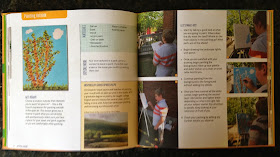I wanted to take a minute to pass on a kind offer from a friend of mine, N.H. artist and gallery-owner Susan Schwake. Susan has offered to send a free signed copy of her new book, Art for All Seasons: 40 Creative Mixed Media Adventures for Children, to the first blog reader who sends me an email and asks for one.
Susan has for years run an array of amazing programs for children of all makes and models: kids in private and public schools, community organizations, programs for medically fragile children, special needs agencies, summer camps, intergenerational facilities, libraries, and her own gallery art school - we're talking about thousands of people whose lives she's enriched with art and art-making.
Susan was an early supporter of my painting endeavor, showing my work in her former Rochester, NH gallery space. She's now making a name for herself in new digs in Dover.
Organized around the four seasons, this is a great source: 140 pages packed with 400 color photos, simple directions, and easy-to-inspire examples. Susan pairs each project with a local artist whose work helped inspire it. I am proud to say that I'm included in the section on "Painting Outside."
 |
| "My" page in Susan's book! |
If you're looking for fun art projects you can do with kids all year round this is a great source. There are good old-fashioned projects (potato-print snowflakes), fun new ideas (make a mandala out of an old LP record), as well as contemporary twists on the traditional (cut-paper quilts and scrap-collage flowers). Best of all, a good number of the projects will work for a wide range of abilities, accommodating beginning artists as well as more sophisticated ones, the limits being only that of imagination and inclination (feather paintings, accordion books, drawing nature, relief printed cards, plein-air painting....). It's impossible not to find at least a few inspired kids' art activities here that will work for you. Check the book out on Amazon here.
Don't believe me? Shoot me an email and see for yourself.













